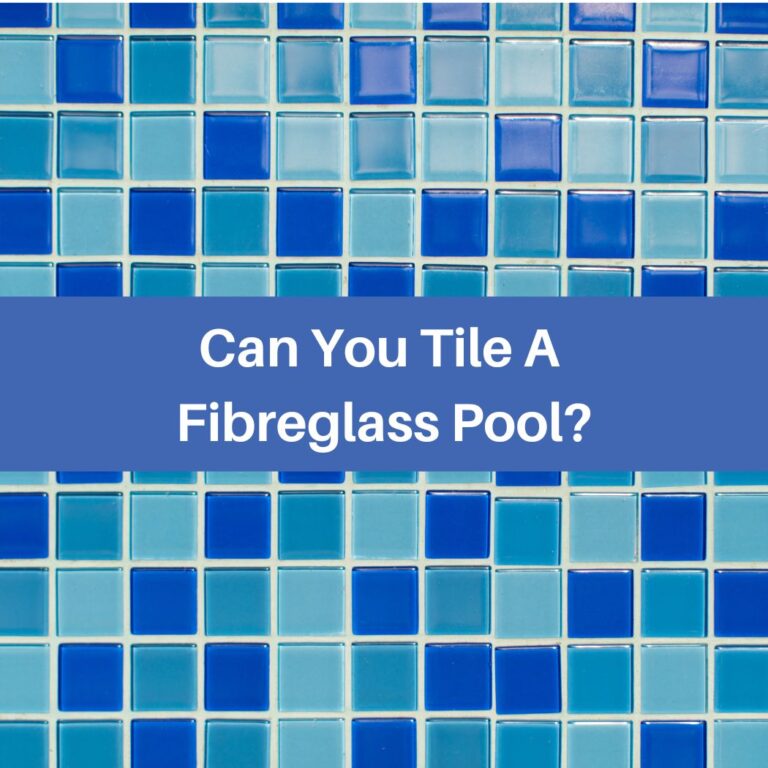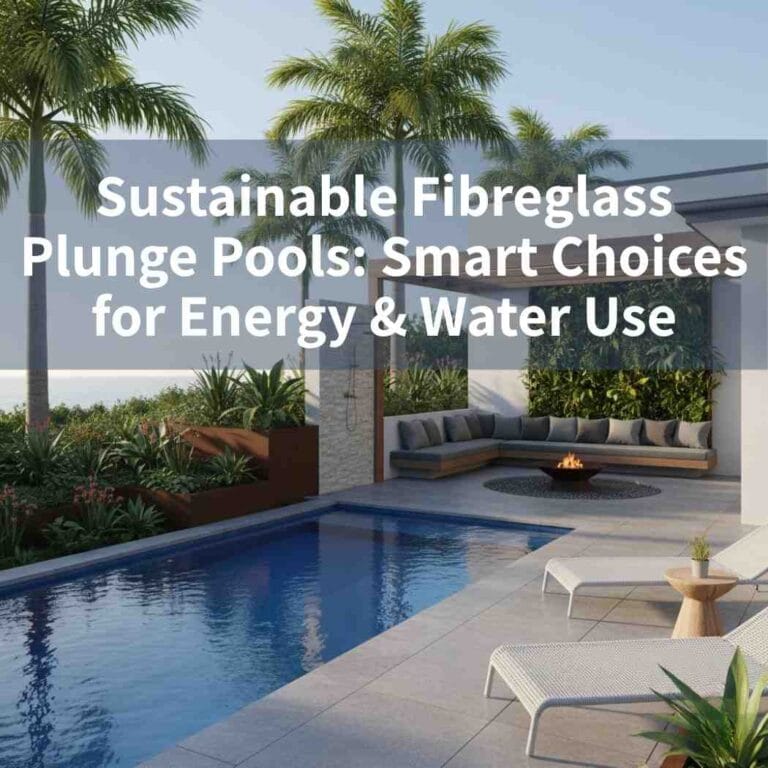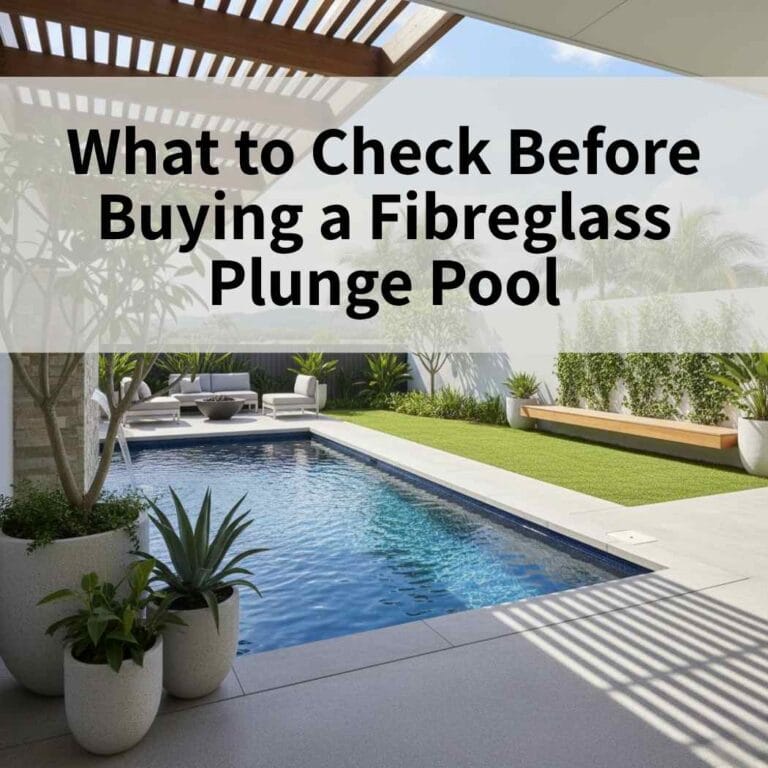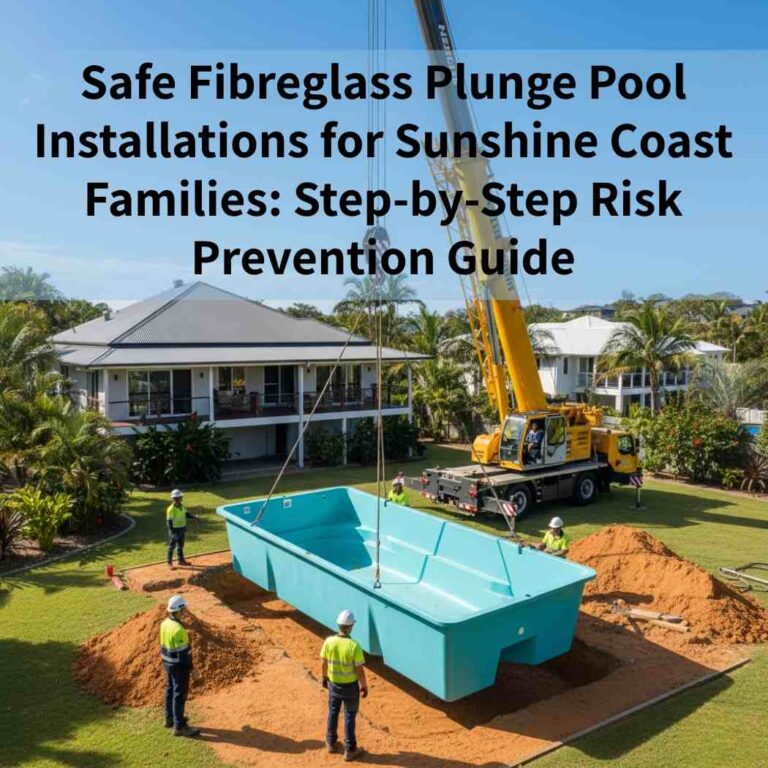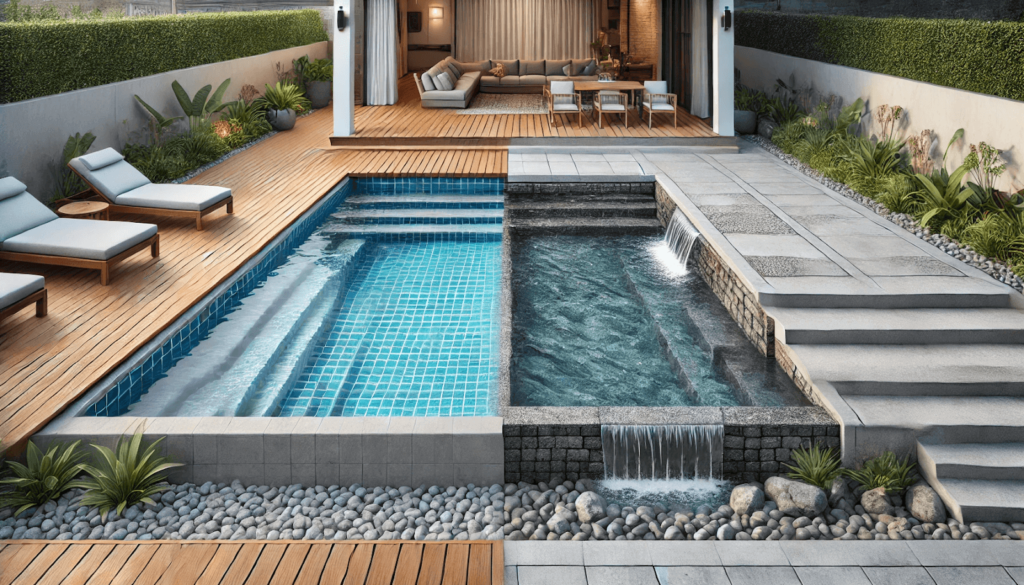
When deciding between a fibreglass and a concrete pool, weighing the pros and cons of each is essential to determine which best suits your needs. Each new pool type offers unique benefits and challenges, so consider cost, customisation, installation time, maintenance, and durability.
Table of Contents
Toggle1. In Short:
Features | Fibreglass Pools | Concrete Pools |
| Installation Time | Quick installation, often within a few days to weeks (1-2 weeks) | 4-8 weeks |
| Initial Cost | Medium $$ ($45,000+) | Medium $$ ($45,000+) |
| Lifespan | 25-30 years | 50+ years |
| Maintenance | Low (less frequent cleaning) due to non-porous surface that resists algae growth | Moderate (more frequent cleaning and chemical treatments) |
| Customisation | Limited to pre-made moulds | Highly customisable |
| Durability | Very durable pools that can last a lifetime or longer | Very durable pools that can last a lifetime or longer |
Fibreglass is likely better if you value low maintenance, quicker installation, and a smoother surface. Conversely, if you prioritize customisation and are willing to invest more time and effort into maintenance, a concrete pool may be more suitable. Both options have unique advantages and drawbacks depending on the pool installed by a reputable company, so consider what aspects are most important to your and your family’s needs.
2. Concrete swimming pools
2.1 What is a concrete swimming pool?
A concrete swimming pool is installed in an in-ground pool that is constructed using a rebar framework that is sprayed or poured with concrete, which is then covered with a protective and decorative plaster layer. This pool can take unparalleled durability and customisation options, allowing homeowners to design pools in virtually any shape, size, or depth and to incorporate various features such as fountains, waterslides, and lights. Constructing a concrete pool involves several stages, including excavation, steel framework installation, plumbing, concrete application, and finishing with plaster or tile.
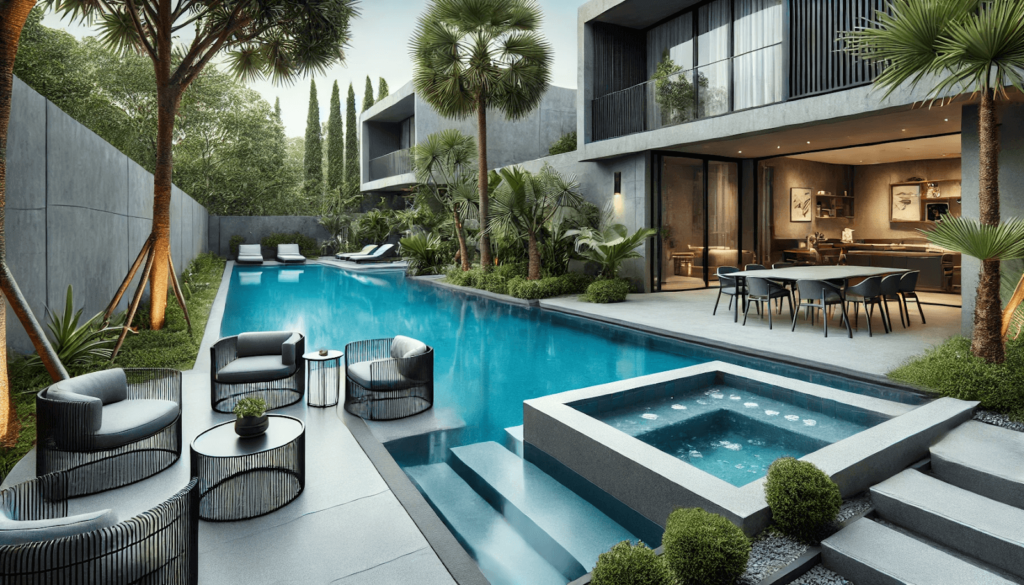
Concrete pools are known for their strength and longevity, and they are capable of withstanding harsh weather conditions and heavy usage. The surface of a concrete swimming pool can be finished in various materials, such as plaster, tile, or pebble, providing a range of aesthetic options. Due to their robust construction and versatility, concrete pools are popular for those looking to create a unique and enduring backyard oasis.
2.2 Design and Construction Method
Concrete pools are built using a rebar framework sprayed or poured with concrete, then covered with a protective and decorative plaster layer. The construction process involves several stages, regardless of whether a pool builder installing a concrete swimming pool or fibreglass.
- Site Selection and Excavation: Choosing the right location and excavating the site to the desired depth and shape.
- Steel Framework Installation: A rebar framework will be placed to provide structural support.
- Plumbing and Electrical Work: Installing plumbing and electrical systems for water circulation, filtration, and lighting.
- Concrete Application: Applying concrete using shotcrete or gunite methods to form the pool shell.
- Curing and Waterproofing: Allowing the concrete to cure correctly and applying waterproofing materials.
- Finishing: Adding a protective and decorative layer of plaster, tile, or other finishing materials.
This method allows for a highly durable and customisable pool structure that withstands heavy usage and harsh weather conditions.
2.3 Size and depth
Concrete pools offer great flexibility in size and depth, allowing for customisation to fit specific needs and preferences, a key consideration in concrete vs fibreglass pools.
- Custom Sizes: Can be designed for any length, width, or shape, from small plunge pools to large lap pools.
- Variable Depths: Can include shallow areas for wading and deeper sections for diving.
For example, a homeowner might opt for a 25-meter lap pool for exercise, while another might choose a freeform lagoon-style pool for aesthetic appeal. Depth can vary significantly, allowing shallow wading areas and deeper diving sections.
2.4 Customisation and additional features
One of the main advantages of concrete pools is their extensive customisation options. Additional Features complement the pool installed, enhancing overall enjoyment. These include waterfalls, fountains, tanning ledges, swim-up bars, integrated lighting, and more, whether you opt for fibreglass or concrete.
- Shapes and Designs: Freeform, geometric, and custom shapes.
- Surface Finishes: Aggregate, tiles, plaster, or other materials.
For example, a homeowner might add a cascading waterfall and a grotto for a resort-like feel or install LED lighting for a dramatic nighttime effect. This level of customisation makes concrete pools a popular choice for those looking to create a bespoke backyard oasis.
2.5 Site accessibility and preparation
Proper site preparation is crucial for successfully constructing a concrete swimming pool. The process begins with a thorough site inspection to evaluate potential challenges such as uneven terrain, wet soil, or underground obstacles. Once the site is assessed, excavation involves removing earth to the desired depth and shape. Grading and drainage systems are installed to ensure proper water flow and prevent structural issues.
Accessibility is also a key consideration, as the site must be accessible for transporting materials and equipment. For example, a sloped backyard might require additional grading and retaining walls to create a level surface for the pool.
2.6 Local labour and material costs
Constructing a concrete swimming pool can vary significantly based on local labour and material costs. Factors influencing the cost include the complexity of the design, the quality of materials used, and the construction team’s experience. Regional variations also play a role, with labour and material costs often higher in major metropolitan areas.
For instance, opting for high-quality concrete and finishing materials may increase the initial investment but ensure greater durability and fewer repairs in the long run. Obtaining multiple quotes and checking contractor credentials is essential to ensure quality workmanship and fair pricing.
2.7 Permits and Regulations
Concrete pool construction requires adherence to local building codes and regulations. Homeowners must obtain the necessary permits and approvals from local authorities before construction begins. This process typically involves submitting detailed plans and specifications for review, including dimensions, plumbing, and electrical details. Inspections are conducted at various stages of construction to ensure compliance with safety and structural standards.
Any pool installation must also comply with specific safety standards, such as fencing and barrier requirements. For example, a building permit is required in many areas, and the concrete pool is required to meet specific safety standards. Consulting with professionals familiar with local requirements can help streamline the permitting process and ensure a smooth construction experience.
3. What are the benefits of a concrete pool?
Concrete pools offer several key advantages. They are unmatched in durability and can withstand harsh weather conditions and chemical treatments, ensuring a long lifespan with proper maintenance. They also provide extensive customisation options, allowing homeowners to design pools in any shape, size, or depth and incorporate features like waterfalls, fountains, and integrated lighting.
Their adaptability to various climates makes them suitable for different geographic locations, and their low maintenance requirements mean they can handle regular use and cleaning without significant damage. Additionally, a well-designed concrete swimming pool can enhance the value of your property, making it a smart long-term investment.
4. What are the downfalls of a concrete swimming pool?
Despite their benefits, concrete pools have some drawbacks. They come with higher costs for both installation and maintenance, including the need for regular cleaning and resurfacing every 10-15 years. The longer construction duration can be inconvenient, often taking several months compared to the quicker installation of other pool types. The rough surface texture can be uncomfortable for swimmers, especially families with young children. Additionally, finding and repairing leaks can be complicated and expensive, adding to the overall maintenance burden. These factors should be carefully considered when deciding whether a concrete swimming pool suits your needs.
5. Fibreglass swimming pools
5.1 What is a fibreglass swimming pool?
A fibreglass pool is a pre-fabricated pool shell made from a composite of glass fibres and resin, known for its smooth, non-porous surface and ease of maintenance. These pools are manufactured in a factory and transported to the installation site, allowing for a quicker installation process that typically takes a few days to a few weeks. Fibreglass pools come in various shapes and sizes, though they are limited to the moulds available from manufacturers, whereas concrete pools tend to offer more customisation options.

The installation involves excavating the site, preparing the base, placing the fibreglass shell, and backfilling around the pool. The smooth surface of a fibreglass pool feels comfortable and contributes to its low maintenance requirements. Fibreglass pools are designed to be durable and can flex slightly to adapt to ground movement, reducing the risk of cracks. Their streamlined manufacturing and installation process makes them a convenient and efficient option for homeowners seeking a hassle-free swimming pool experience, a key benefit when considering whether to buy a fibreglass or concrete pool.
Our complete guide to fibreglass pools breaks down every factor homeowners should consider before buying one, so you might check this out too.
5.2 Cost of a fibreglass pool
The cost of installing a fibreglass pool can vary widely based on several factors, including the pool’s size, shape, and additional features – you can find out the costs and inclusions of a fibreglass pool in Sunshine Coast here. The average cost ranges from $40,000 to $50,000, but it can go up to $100,000 or more for larger, more elaborate designs. The initial pool cost includes the shell, excavation, delivery, installation, and basic equipment like pumps and filters. While fibreglass pools may have a higher upfront cost than vinyl liner pools, they offer long-term savings due to their lower maintenance requirements and durability.
Before committing to any design or size, reviewing how much fibreglass pools typically cost in Australia can help you plan your budget with confidence.
5.3 Design of the pool
Fibreglass pools come in various shapes and sizes, catering to different tastes and backyard layouts. Common shapes include classic linear, free-form, Roman, and kidney-shaped designs. These pools can also be customised with inlaid tiles, tanning ledges, bubblers, and LED lights to enhance their aesthetic appeal and functionality. A pool builder can help you integrate these features seamlessly. The smooth, non-porous surface of fibreglass pools looks elegant and makes them easier to clean and maintain.
5.4 Installation process
Installing a fibreglass pool is relatively quick and straightforward compared to other types of pools, especially when you choose professional fibreglass pool installation handled by an experienced local team. Depending on the project’s complexity, the process generally takes a few days to a few weeks. The main steps include:
- Laying Out the Pool: Marking the placement of the pool surface in the yard.
- Excavation: Digging the hole according to the pool’s dimensions, whether an inground pool made of concrete or fibreglass.
- Setting the Floor: Laying a bed of gravel for the pool base.
- Reinforcement and Bond Beam: Adding structural support.
- Coping and Deck: Finishing touches around the pool.
5.5 Maintenance and repair
Fibreglass is typically known for its low maintenance requirements. The smooth, non-porous surface resists algae growth, reducing the need for frequent cleaning and chemical treatments. Basic maintenance tasks include:
- Regular Cleaning: Using a skimming net and pool vacuum.
- Water Chemistry: Regularly testing and balancing the water’s pH, chlorine, and alkalinity levels.
- Filter System: Running the pool filter daily to keep the water clean is essential for any pool owner.
Repairs are also minimal, but if needed, they are generally easier and less costly than concrete pools.
- Low Maintenance: Less frequent cleaning and chemical use
- Basic Tasks: Skimming, vacuuming, water testing
- Repair: Minimal and less costly
5.6 Longevity and warranty
Fibreglass pools are incredibly durable and can last over 30 years if properly maintained. The longevity of a fibreglass pool is mainly due to its robust construction and resistance to algae and chemical damage, favouring fibreglass in the concrete vs fibreglass pools debate. Most manufacturers offer extensive warranties to back up their products, often including:
- Structural Warranty: This typically covers the pool for its lifetime, whether it is a concrete or fibreglass pool.
- Surface Warranty: Covers the gel coat surface for 7-10 years.
These warranties provide peace of mind and ensure that issues can be addressed promptly and effectively.
- Longevity: Over 30 years with proper maintenance
- Warranties for both concrete and fibreglass pools.: Structural (lifetime), Surface (7-10 years)
- Durability: Resistant to algae and chemical damage
6. What are the advantages of fibreglass pool?
Fibreglass pools offer several key advantages. One of the primary benefits is their low maintenance. The smooth, non-porous surface resists algae growth, reducing the need for frequent cleaning and chemical treatments. Quick installation is another significant advantage, as fibreglass pools can typically be installed within a few days to a few weeks. The durability of fibreglass pools is also noteworthy; they are resistant to cracking and can last well over 30 years with proper care.
Additionally, fibreglass pools are appealing because they are cost-effective over the long term, as they require fewer repairs and less maintenance than other pool types. Finally, fibreglass pools come with extensive warranties, often including lifetime structural warranties and 7—to 10-year surface warranties, providing peace of mind for homeowners.
7. What are the downfalls of a fibreglass pool?
Despite their benefits, fibreglass pools have some drawbacks. One of the main limitations is the lack of customisation. Fibreglass pools come in pre-made moulds, restricting the variety of shapes and sizes available. This can disadvantage homeowners looking for a highly customised pool design. Initial costs can also be higher than vinyl liner pools, although they tend to be more cost-effective in the long run.
Additionally, transportation and installation require careful planning and access, as the pool needs to be delivered in one piece, which can be challenging for properties with limited access. Lastly, the pool typically requires minimal repairs but can be more complex if the gelcoat surface is damaged, requiring specialized repair techniques.
8. Conclusion
When choosing the best pool, a fibreglass pool installed is generally the better option for many existing pool owners. Many existing pool owners who have owned both types of pools report that fibreglass pools are warmer. Its low maintenance, quick installation, and long-term durability make it a more convenient and cost-effective choice.
While concrete pools typically offer extensive customisation, the higher costs (if the pool is bigger), longer construction time, and increased maintenance requirements often outweigh these benefits for many people. Therefore, for a hassle-free and durable swimming experience, a fibreglass pool is the right pool and a superior choice.
If you’re ready to invest in a large, durable fibreglass swimming pool, contact our fibreglass pool experts in Sunshine Coast to start designing and installing yours today.
9. FAQ
9.1 Are concrete pools cheaper than fibreglass?
No, concrete pools are not cheaper than fibreglass. They’re both around the same price. Fibreglass and concrete pools can often be compared when it comes to the initial investment. Both a small concrete and a small fibreglass pool usually start at around $40,000, depending on the site conditions. The cost of manufacturing the fibreglass mould, then having the mould transported to the site, and finally hiring the crane to lift the pool into the pre-dug hole usually ties up with the intense labour of creating the concrete pool on site. However, the bigger the pool and the more customisation, the higher the invoice and the longer the finishing process of a concrete pool.
9.2 What is the life expectancy of a concrete pool?
Properly maintained, a concrete pool’s life expectancy is around 50 years or more. Regular maintenance, such as brushing the pool to remove algae and bacteria, acid washing, and sealing cracks, is essential to ensure the pool remains in excellent condition and extends its lifespan.
9.3 What type of pool is most cost-effective?
According to many pool owners, Fibreglass pools are generally the most cost-effective option in the long run. The smooth, non-porous surface of fibreglass pools resists algae growth, reducing the need for frequent cleaning and chemical treatments and contributing to their cost-effectiveness.
9.4 Are fibreglass pools slippery?
No, fibreglass pools have a smooth, non-porous gel coat finish that can feel glossy. While this finish is generally smooth, steps or ledges in fibreglass pools often have an anti-slip texture to enhance safety. This makes fibreglass pools comfortable to walk on without being overly slippery.
9.5 Do fibreglass pools crack?
No, fibreglass pools are designed to be durable and flexible, which helps them resist cracking. However, they can develop cracks if subjected to extreme conditions or improper installation. These cracks are usually minor and can be repaired relatively easily compared to concrete pools.

